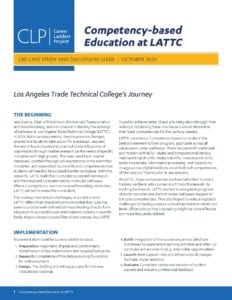Los Angeles Trade Technical College’s Journey
The Beginning
Jess Guerra, Chair of the School of Advanced Transportation and Manufacturing, was instrumental in leading the redesign of pathways at Los Angeles Trade Technical College (LATTC) in 2010. Static success metrics, despite previous changes, spurred the faculty to take action for a redesign. Jess and the rest of faculty leadership planned to identify points of opportunity through market research on the needs of specific industries with high growth. The team used labor market databases, combed through job descriptions in the identified industries, and researched future skills and competencies that students will need to be successful in the workplace. With this research, LATTC built their Competency Model Framework and then mapped competencies to curricular pathways. Where a competency was not covered in existing curriculum, LATTC set out to revise the curriculum.
The redesign had unique challenges; as a trade school, LATTC differs from liberal arts schools in that their goal has been to provide well-defined pathways leading directly from education to successful post-matriculation careers in specific fields. Majors always included liberal arts courses, but LATTC hoped to achieve better liberal arts integration through their redesign, bolstering these courses as a crucial element in their basic competencies for 21st century careers.
LATTC considers a “competency-based curriculum” the bedrock element to their program, applicable across all subsequent career pathways. These include both traditional and modern soft skills—digital and computational literacy, math and English skills. Analytical skills, interpersonal skills, ability to execute, information processing, and capacity to change across digital mediums are all hallmark competencies of 21st century “hybrid jobs” in any industry.
At LATTC, these competencies are fused into their industry training via liberal arts courses in a STEAM framework. By working backwards, LATTC worked to reorganize programs of study into nine new distinct career pathways mapped to the core competencies. They also hoped to reduce logistical challenges by finding a way to consolidate student needs into fewer office visits so that counseling might be more effective and more frequently utilized.
Implementation
Implementation could be summarized in six steps:
-
- Preparation: Alignment of goals and commitment; identification of key stakeholders and targeted industries
- Research: Compilation of the data providing foundation for redevelopment
- Design: The drafting and vetting process for the new institutional roadmap
- Build: Integration of the course sequences which are buttressed by experiential learning activities and other cocurricular enhancements (e.g., internship opportunities)
- Launch: New support roles and infrastructural changes facilitate implementation
- Evaluate: Consistent review and revision of student success and industry professional feedback
Planning the nine career pathways began in 2010, and implementation rolled out beginning in 2014 in groups of three to ease re-organization strain. Counseling and registration roles were consolidated under one roof and supported with a new counseling position, the Student Support Specialist, cross-trained in financial aid, academic counseling, and registration. The nine revised pathways were developed from a data-driven approach via information from ONet, MC, and other databases. LATTC vetted changes with industry professionals to ensure their efficacy in preparing matriculated students for those specific industries.
The result is nine successfully redeveloped pathways; each pathway is cross-cut with STEAM based core competencies, certificate programs, internship opportunities and workshops (see table for a sample pathway). Each pathway matriculates students through tiers of competencies, beginning with the most general and culminating in the most career-specific: Foundational Competencies; Academic and Career Readiness Competencies; Industry-Wide Competencies; OccupationSpecific Technical Competencies; and, finally, Specialty Competencies. Care was taken in preparing counselors to assist building graduate resumes that highlight the direct applicability of pathway courses and certifications for their desired industry. Extraneous classes across all LATTC programs were eliminated, reducing the number of units overall to complete programs—Automotive Development, for example, was reduced from 44 units to 36 units, facilitating greater retention and a higher completion rate.
Initial program reviews show promising results already, as reported in 2018 and 2019. Completion rates, post-program employment, and the number of students earning a living wage and beyond have all increased. Further data will be collected through the 2020-2021 academic year.
Why Competency-based Education?
The Vision for Success is focused on closing equity gaps across the state of California. The California Community College’s Curriculum Committee has identified competency-based education (CBE) as one strategy that can provide the flexibility needed by some students to complete their educational goals. CBE is not meant to replace our traditional instructional model, but is meant to supplement college’s instructional offerings for students. Some programs may be more appropriate for a CBE model than others. Furthermore, some programs may be appropriate for a direct assessment CBE model, while others may need in-person learning or activities to ensure student learning. These programs may be able to offer a hybrid CBE model.
(As of July 2020, the CCCCO is working to establish a funding model for Direct Assessment CBE programs.)